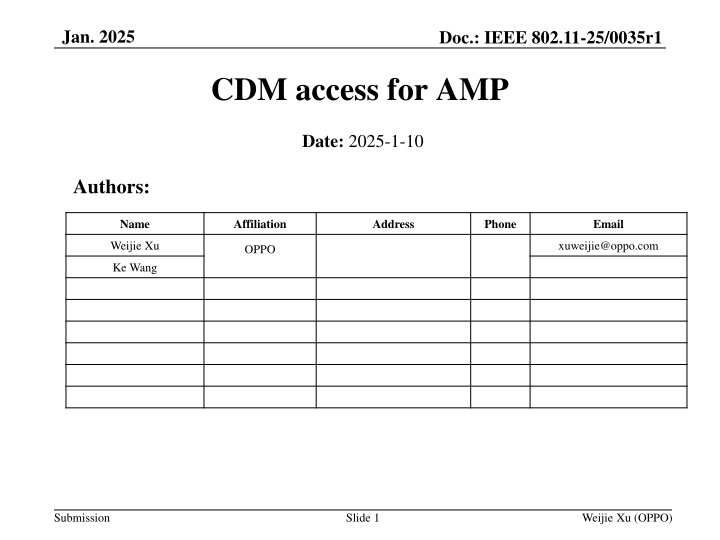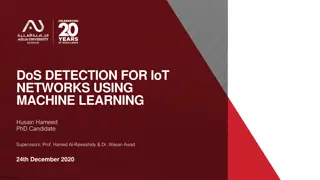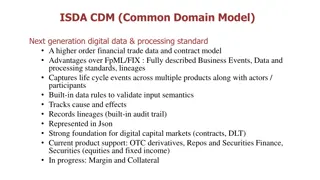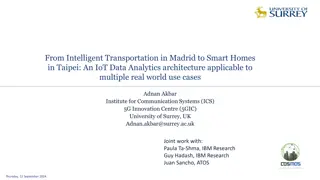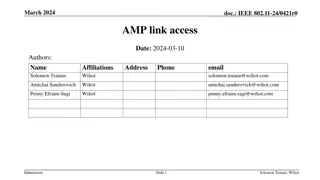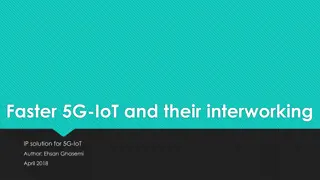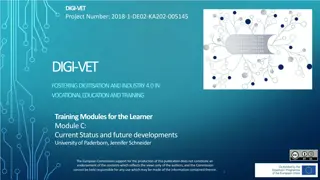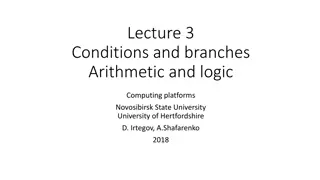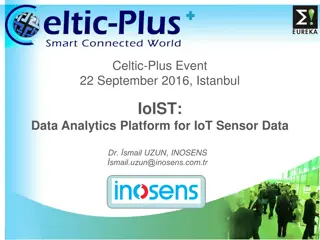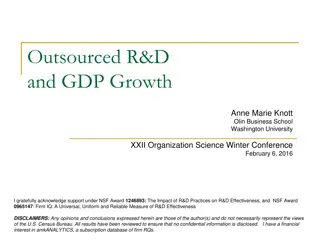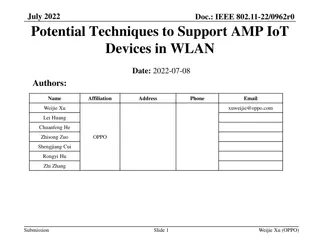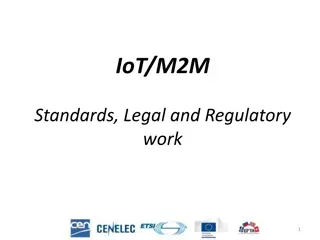CDM Access Procedure for AMP in IoT
This submission discusses the CDM access procedure for AMP in IoT, highlighting the advantages it offers in providing more access opportunities compared to traditional methods. It delves into the background of RFID access procedures and the significance of fast identification in AMP communication systems. The feasibility of supporting CDM access for AMP is explored, emphasizing the low complexity in generating CDM codes. The submission touches on various aspects such as trigger codes and the use of OOK waveform for uplink communication, offering insights into enhancing communication efficiency in IoT environments.
Download Presentation

Please find below an Image/Link to download the presentation.
The content on the website is provided AS IS for your information and personal use only. It may not be sold, licensed, or shared on other websites without obtaining consent from the author.If you encounter any issues during the download, it is possible that the publisher has removed the file from their server.
You are allowed to download the files provided on this website for personal or commercial use, subject to the condition that they are used lawfully. All files are the property of their respective owners.
The content on the website is provided AS IS for your information and personal use only. It may not be sold, licensed, or shared on other websites without obtaining consent from the author.
E N D
Presentation Transcript
Jan. 2025 Doc.: IEEE 802.11-25/0035r1 CDM access for AMP Date: 2025-1-10 Authors: Name Affiliation Address Phone Email Weijie Xu xuweijie@oppo.com OPPO Ke Wang Submission Slide 1 Weijie Xu (OPPO)
Doc.: IEEE 802.11-25/0035r1 Jan. 2025 Abstract This submission is to discuss CDM access procedure for AMP IoT. CDM access is able to provide more access opportunities compared without CDM(e.g. only use TDM and/or FDM). Submission Slide 2 Weijie Xu (OPPO)
Jan. 2025 Doc.: IEEE 802.11-25/0035r1 Background(1) In RFID, slot-aloha is used as the access procedure. The access timing is fully provided/controlled by the interrogator RFID device determines whether to access based on the its random number and the control of Query/QueryRep RN16 is the 1st message that RFID device send to the interrogator When there are collisions among RFID tags, RN16 can not be correctly decoded Figure: slot-Aloha in RFID[2] Submission Slide 3 Weijie Xu (OPPO)
Jan. 2025 Doc.: IEEE 802.11-25/0035r1 Background(2)[1] As discussed in [3], one of the most important scenarios is where there are large number of devices - E.g. in logistics and warehouse scenarios - E.g. sensors in smart manufacturing scenario In many of the concerned use cases as in [3], the purpose of AMP communication is to poll AMP data (e.g. sensor data, EPC code etc.). The ID may be unknown by the AP in these use cases. When an AMP device is trying to access the system, fast identification of an AMP device is very important. AMP system shall be able to provide sufficient access opportunities in order to reduce collisions and speedy the access process. In [4], multiple access for AMP was discussed, we propose to study TDM, FDM and CDM. In[5], we will further discuss TDM and FDM for AMP. In this submission, CDM access for AMP will be discussed. Submission Slide 4 Weijie Xu (OPPO)
Jan. 2025 Doc.: IEEE 802.11-25/0035r1 Access procedure with CDM codes CDM code will be the first message from AMP device when it is triggered/polled. When CDM code is detected by AP, this CDM code can be used to identify AMP device for the consequent communication. Since the AMP device is identified, the following transmission can be scheduled by AP thus there will be no collision any more. AMP AP AMP trigger AMP STA 1 Slot 1/Code m Slot 2 AMP STA 2 Slot 1/Code n Slot 2 Figure 1 Triggered CDM codes from multiple AMP STAs Submission Slide 5 Weijie Xu (OPPO)
Jan. 2025 Doc.: IEEE 802.11-25/0035r1 Feasibility of supporting CDM access for AMP Although with low complexity, AMP device is able to generate CDM code. As discussed in [6], OOK waveform is proposed as the uplink waveform. There are candidate binary CDM codes (e.g. m/Gold sequence) that can work in conjunction with OOK. Impact of non-ideal factors Synchronization error CDM sequence from different AMP devices may be not synchronous at the beginning of transmission due to different distance from the AP or different clock drifting time AMP STA 1 CDMA code m AMP STA 2 CDMA code n Clock drifting During the transmission, the relative distance of two CDM sequence may change due to different clock drifting rate of different AMP devices. AMP STA 1 CDMA code m AMP STA 2 CDMA code n Submission Slide 6 Weijie Xu (OPPO)
Jan. 2025 Doc.: IEEE 802.11-25/0035r1 Feasibility of supporting CDM access for AMP Analysis of non-ideal factors Analysis: RTT of different AMP STA The coverage of one AMP AP will be 10m~20m, so the RTT(Round Trip Time) is only 0.067us~0.133 us Drifting For active device with clock accuracy of 1000ppm, the max drifting time after a time duration of 2ms is 2us. For active device with clock accuracy of 1000ppm, for a CDM sequence of length 63, the symbol level misalignment between 2 CDM sequences is less than 1/10 OOK symbol (for one bit of the sequence) Submission Slide 7 Weijie Xu (OPPO)
Jan. 2025 Doc.: IEEE 802.11-25/0035r1 Exemplary CDM Code for AMP Both M sequence and gold sequence are binary sequences. AMP device is able to generate m or gold sequence with low- complexity implementation. M or Gold sequence can be generated with OOK waveform Both m sequence and Gold sequence have good auto-correlation and cross-correlation. Sufficient number of sequences can be generated with m sequence/Gold sequence and their cyclic-shift sequences. 1 0.9 0.8 0.7 Correlation result 0.6 0.5 0.4 0.3 0.2 0.1 0 0 500 1000 1500 2000 2500 3000 Auto-correlation of M sequence Submission Slide 8 Weijie Xu (OPPO)
Jan. 2025 Doc.: IEEE 802.11-25/0035r1 Simulation assumptions Link level simulations are performed for CDM codes with the following simulation assumptions. Table 1: Simulation assumptions Parameters Values Sequence types m-sequence, 2 Channel D 0.0dB 2 s 20MHz OOK 10 63 +-1000ppm Number of devices / sequences Channel model SNR Chip duration Sampling rate at the AP Modulation Cyclic shift of m- and Gold sequences Sequence length Clock accuracy Submission Slide 9 Weijie Xu (OPPO)
Jan. 2025 Doc.: IEEE 802.11-25/0035r1 Case 1 2 Users transmit CDM code on the same resource. 2 codes are aligned in the beginning of transmission. Channel D, 1000ppm. Equal or non-equal receiving power at the AP side 1 1 0.9 0.9 0.8 0.8 0.7 0.7 Correlation result Correlation result 0.6 0.6 0.5 0.5 0.4 0.4 0.3 0.3 0.2 0.2 0.1 0.1 0 0 0 500 1000 1500 2000 2500 3000 0 500 1000 1500 2000 2500 3000 2 AMP STAs, 10dB power difference 2 AMP STAs, equal power Submission Slide 10 Weijie Xu (OPPO)
Jan. 2025 Doc.: IEEE 802.11-25/0035r1 Case 2 2 CDM codes are not synchronous at the beginning and there is a 2us mis- alignment (Corresponding to 1 chip and 40 sampling points) between the 2 CDM sequence, Channel D, 1000ppm. 1 X 858 Y 0.998187 1 X 897 0.9 0.9 Y 0.992104 0.8 0.8 0.7 0.7 Correlation result Correlation result 0.6 0.6 0.5 0.5 0.4 0.4 0.3 0.3 0.2 0.2 0.1 0.1 0 0 0 500 1000 1500 2000 2500 3000 0 500 1000 1500 2000 2500 3000 2 AMP STAs, Aligned 2 AMP STAs, 2us timing misalignment Submission Slide 11 Weijie Xu (OPPO)
Jan. 2025 Doc.: IEEE 802.11-25/0035r1 Comparison of CDM codes and RN16(1) RN16 is used as access code in RFID. It is fragile in case of collision and channel fading. Under the same situation, CDM code is better than RN16. When the receiving power from multiple AMP STAs has similar power, CDM codes with similar power outperforms RN16 based on the simulations. When the receiving power from multiple AMP STAs are different (e.g. 10dB difference) For RN16, at most one RN16 may be decoded correctly and the other will fail For CDMA, at least one CDMA code can be correctly decoded and there is probability to correctly decode another one. Submission Slide 12 Weijie Xu (OPPO)
Jan. 2025 Doc.: IEEE 802.11-25/0035r1 Comparison of CDM codes and RN16(2) When RN16 from multiple AMP STAs collides on the same resources, and the receiving power from multiple AMP STAs are similar, RN16 from all the AMP STAs can t be decoded. RN16 Two users (Equal power) 100 OOK 10-1 BLER 10-2 10-3 -10 -9 -8 -7 -6 -5 -4 -3 -2 -1 0 1 2 3 4 5 6 7 8 SNR (dB) Decoding performance of RN16 when there is collision Submission Slide 13 Weijie Xu (OPPO)
Jan. 2025 Doc.: IEEE 802.11-25/0035r1 Observations Based on the simulation results, the following can be observed: There is obvious advantage of CDM access code than RN16, when there is collision on the same access resource With proper selection of the CDM codes (e.g. use big cyclic shift to overcome the potential timing misalignment), the impact from synchronization error can be easily handled, at least for active AMP device, with a clock accuracy of 1000ppm Submission Slide 14 Weijie Xu (OPPO)
Jan. 2025 Doc.: IEEE 802.11-25/0035r1 Summary and proposals In this submission, CDM access is discussed and its feasibility and the advantage over RN16-like message is analyzed. Based on the discussion, it is proposed to support CDM access code for at least active AMP device. Submission Slide 15 Weijie Xu (OPPO)
Jan. 2025 Doc.: IEEE 802.11-25/0035r1 Straw Poll #1 Do you agree with the following text: CDM access is supported for active AMP STA. Yes No Abstain Submission Slide 16 Weijie Xu (OPPO)
Jan. 2025 Doc.: IEEE 802.11-25/0035r1 Reference 1. IEEE 802.11-24/0826r0, Energy balance of the state-based AMP station 2. Specification for RFID Air Interface Protocol for Communications at 860 MHz 960 MHz 3. IEEE 802.11-23/0436r0 Technical Report on support of AMP IoT devices in WLAN 4. IEEE 802.11-24/1501r0 Multiple Access for AMP IoT 5. IEEE 802.11-24/1776r0 Multiple access mechanisms for AMP 6. IEEE 802.11-24/1780r0 Further Discussion on AMP PPDU Design Submission Slide 17 Weijie Xu (OPPO)
